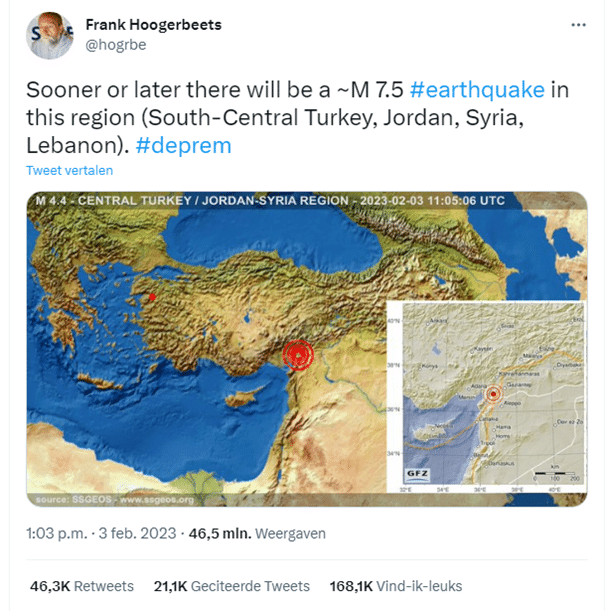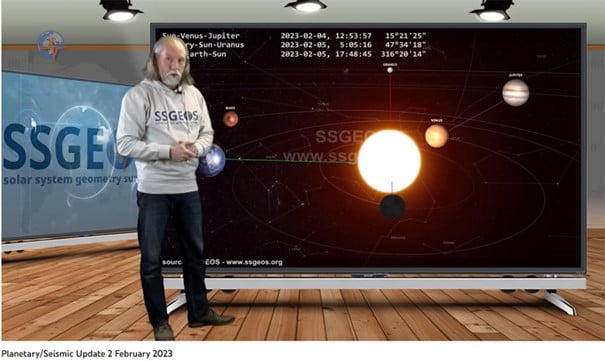On Monday, February 6, 2023, early in the morning, the border area between south east Turkey and north west Syria was hit by an earthquake, measuring 7.8 on the Richter scale, causing massive destruction and casualties in both countries. The death toll has already passed 21,000 and will undoubtedly rise further. Help has been offered from many countries, and rescue efforts continue.
The area is quite prone to earthquakes, as it is at the meeting point of two tectonic plates: the Arabian and the Anatolian plates. The tensions that build up between the two plates are periodically discharged in earthquakes – some small, and some large. Unfortunately, even with access to the most up to date scientific methods, it is difficult to predict exactly when each earthquake will take place, and so there is little possibility of avoiding the inevitable consequences.
In the midst of the enormous media attention that this disaster generated, the name Frank Hoogerbeets has risen to the surface. On February 3rd, a few days before the earthquake, he posted an image on Twitter in which the disaster area was circled very precisely. The tweet read:

Sooner or later there will be a ~M 7.5 #earthquake in this region (South-Central Turkey, Jordan, Syria, Lebanon). #deprem
In a matter of days the tweet received over 45 million views. Hoogerbeets has over one million Twitter followers by now.
Leaving aside the vague phrase “sooner or later,” the accuracy of this prediction is astonishing, both in terms of time, place and intensity of the quake. Was this mere coincidence, or was it spectacular evidence of his foresight?
“Planetary Geometry”
Hoogerbeets is a self-proclaimed earthquake forecaster, who – using proprietary software that kept track of planet positions in the solar system at his own Solar System Geometry Survey (SSGeos) research institute – claims to have predicted numerous, mainly severe, earthquakes. In his opinion, these earthquakes were (partly) triggered by specific planet positions, which are known in astrology as conjunctions (0 degrees), trines (270 degrees) and oppositions (180 degrees). Thus was born the self-developed discipline of “planetary geometry.”
Hoogerbeets has made predictions about imminent earthquakes in numerous videos on YouTube in recent years. He has also analysed past earthquakes, demonstrating his theory that they are almost always preceded by certain planet positions. Of course, Hoogerbeets is familiar with the scientific theory of plate tectonics, but in his opinion specific planet positions always provided the final push.
On his SSGeos website he briefly explains his theory: he is not so much concerned with the gravitational pull exerted on the earth’s crust by the planets and the moon, but with electromagnetic forces. According to him, the influence of the planets on atmospheric conditions had already been demonstrated by radio amateur John H. Nelson, who, in the 1940s, 1950s and 1960s, had shown by means of short-wave radio communication that planet positions influence the Earth’s atmosphere. As Hoogerbeets explains:
Of nearly 1,500 atmospheric condition forecasts that he made in 1967 he had an accuracy rate of 93.2%. His forecast methods, while seemingly forgotten, have not been refuted to date.
Hoogerbeets admits that the critical planet positions do not always lead to major earthquakes – only when the tensions in the earth’s crust have run high – and that that sometimes they do not produce any discernible effect at all. Nevertheless, he advocates further investigation of these planet positions as warning signs for future quakes.
Since the earthquake, Twitter has added the following warning to some of Hoogerbeets’ tweets (with some links to earthquake science websites):
There is no scientific basis for earthquake predictions. There is always a chance for earthquakes in places with active faults, but specific forecasts perform no better than random when tested. Claims of correlation with planetary alignment have been disproven.

Yet science is not completely ignorant of the idea that, for example, the moon influences the occurrence of earthquakes. As reported in Nature :
Big earthquakes, such as the ones that devastated Chile in 2010 and Japan in 2011, are more likely to occur during full and new moons — the two times each month when tidal currents are highest.
The recent earthquake in Turkey and Syria also happened just after the full moon of February 5. However, crucially, this article highlights the influence of gravitational effects – it is not about electromagnetism.
If we examine the (only) source that Hoogerbeets mentions as proof of the electromagnetism hypothesis, we can see that Nelson’s research has indeed received some criticism. Nelson’s findings turn out to be largely artifacts, given that:
Randomicity tests show that the apparent association of radio disturbance days with planetary position is an artifact of Nelson’s counting method.
It is also worth noting that the link Hoogerbeets draws between atmospheric disturbances and earthquakes was never actually made by Nelson.
Express doubts
If we check where Hoogerbeets may have published about his findings, we come across the British tabloid Daily Express, whose “Weird” category regularly published sensational articles referencing the “seismic psychic” Frank Hoogerbeets. Notably, those articles were published by journalist Sean Martin, whose LinkedIn page describes his role at the paper as “developing and creating stories which have the potential to go viral”. The selection includes:
- Earthquake WARNING: Totally DESTRUCTIVE tremor to strike NEXT WEEK – shock claim – Thu, Feb 14, 2019
- Earthquake WARNING: ‘Huge MEGA-THRUST to strike’ by end of February – Mon, Feb 11, 2019
- Earthquake WARNING: Magnitude NINE tremor to hit by February 26 – shock claim – Mon, Feb 25, 2019
Invariably, these articles are concluded with the remark that scientists see no merit to Hoogerbeets’ theories, but not many readers will have noticed that.
Unsurprisingly, then, the recent earthquake is also covered by this paper (though Martin has moved to pastures new), and again it comes with the disclaimer:
However, Mr Hoogerbeets predictions has been slammed by critics within the scientific community who claimed the theory is not universally accepted
A search by “Frank Hoogerbeets” on the Express website produces an incredible 76 articles of hits, each more sensational than the next, stretching back to 2015. It should be clear that these publications are deadly to one’s scientific reputation.
Earthquakology
If we generally look at what is known about whether earthquakes can actually be predicted, the Wikipedia page “Earthquake prediction” offers little hope:
There have been around 400 reports of possible precursors in scientific literature, of roughly twenty different types, running the gamut from aeronomy to zoology. None have been found to be reliable for the purposes of earthquake prediction.
And a recently published report on earthquake forecasting draws an equally sober conclusion:
The search for diagnostic precursors has not yet produced a successful short-term prediction scheme.
It appears that Hoogerbeets will have to substantiate and publish his theory, if he is to be taken seriously. In particular, he must be able to demonstrate how electromagnetic disturbances in the atmosphere can influence earthquakes (something that would almost certainly be far more difficult than affecting radio communication).
Although Hoogerbeets is not an astrologer, he borrows concepts like conjunction and opposition between planets, to which he attributes far-reaching influences. However, unlike horoscope astrology, his model seems to be drawn from the perspective of the sun, rather than the earth. Yet he also receives criticism from contemporary astrologers, given that the idea that planets can exert any physical influence on us at all – let alone cause major earthquakes – is considered outdated in these circles. Even astrologers, then, can see there is no merit to Hoogerbeets’ “Earthquakology”.
This article is translated from the original Dutch at kloptdatwel.nl. Disaster relief efforts are still going on, to offer aid to those affected by the earthquake. You can support the efforts by donating to organisations like Médecins Sans Frontières Emergency Fund or the Turkey Mozaik Foundation Kahramanmaras Earthquake Emergency Relief Fund.



